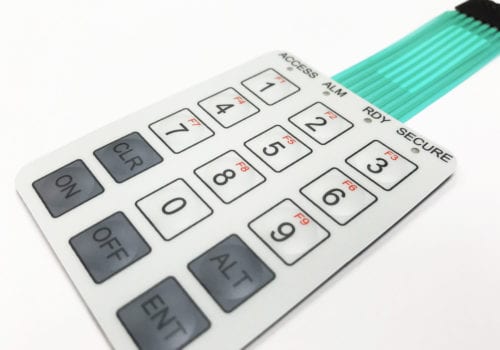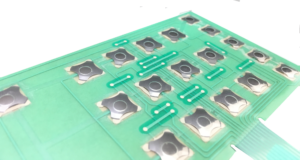Why Membrane Switches Are Vital for Sturdy Control Systems
Membrane switches play a pivotal role in making certain the longevity and integrity of control systems throughout different industries. As we explore the complex benefits of membrane switches, it becomes evident that their value goes beyond mere functionality, affecting individual experience and operational performance.
Overview of Membrane Layer Switches
Membrane layer switches are functional and trustworthy components generally used in various digital control systems. These switches are composed of several layers, consisting of a graphic overlay, a spacer layer, and a printed circuit layer. The visuals overlay offers both useful and aesthetic layout, while the spacer layer guarantees that the buttons are triggered just when pressed. The published circuit layer contains conductive traces that complete an electric circuit when the membrane is pushed, enabling the gadget to react to user inputs.
Membrane layer buttons are usually preferred in applications calling for a small and light-weight style, making them optimal for handheld tools, medical tools, and industrial machinery. They can be tailored to meet particular individual needs and can incorporate different functions such as backlighting, responsive responses, and multiple colors. Membrane layer buttons are immune to dirt, moisture, and contaminants, making them appropriate for atmospheres where toughness is crucial.
Benefits of Durability
In numerous applications, the sturdiness of membrane changes offers considerable advantages that improve their general performance and reliability. These switches are developed to endure severe atmospheres, making them optimal for use in demanding conditions such as high humidity, severe temperature levels, and direct exposure to chemicals. Their durable building assists to avoid damage from physical impact, ensuring long-lasting functionality and minimizing the demand for constant substitutes.
Furthermore, membrane switches are immune to damage, which is vital in applications where regular interaction takes place. This longevity converts to reduce maintenance prices, as companies benefit from reduced downtime and less service interruptions. The encapsulated layout of membrane switches secures interior components from dirt and dampness access, further adding to their lifespan (membrane switch).
An additional benefit is their ability to preserve consistent efficiency in time. With a high resistance for mechanical tension, these buttons protect their tactile responses and electrical honesty, guaranteeing customer complete satisfaction. Inevitably, the sturdiness of membrane changes not just enhances functional efficiency however additionally promotes self-confidence in their reliability, making them a favored choice for control systems across numerous sectors.
Applications in Different Industries
Durable control systems utilizing membrane layer buttons find substantial applications across a variety of industries, each gaining from the one-of-a-kind attributes these switches use. In the medical sector, membrane layer buttons are critical for devices such as patient monitors and analysis equipment, where reliability and convenience of cleaning are extremely important. Their resistance to dampness and contaminants ensures they keep capability in clean and sterile atmospheres.
The auto market leverages membrane buttons for dashboard controls and infomercial systems, where they offer smooth, low-profile interfaces that boost customer experience. These switches are also made to stand up to harsh problems, including exposure to extreme temperature levels and vibrations.
In commercial setups, membrane switches are frequently utilized in machinery control panels, using responsive responses and longevity required for high-usage applications. Their capacity to stand up to chemicals makes them ideal for producing atmospheres where spills and pollutants are regular.

Consumer electronic devices, such as kitchen devices and push-button controls, additionally use membrane layer switches for their adaptability and cost-effectiveness. Overall, the versatility and durable nature of membrane layer changes make them vital across various sectors, making certain effective operation and longevity in control systems.
Layout and Visual Appeal
While capability is extremely important, the style and aesthetic allure of control systems furnished with membrane buttons play a vital role in customer involvement and general experience (membrane switch). The visual design of these buttons can substantially influence user assumption and interaction. A properly designed membrane switch improves the beauty of the tool, her latest blog making it much more appealing to individuals and fostering a link between the customer and the product
Membrane layer switches use a large amount of adaptability in design, permitting producers to tailor graphics, colors, and appearances to align with brand name identification and product aesthetics. Using lively colors and distinct patterns can draw interest, while responsive comments can reinforce the individual's communication with the gadget. In addition, the ability to integrate LED indications and backlighting into the membrane layer switch layout offers both useful and aesthetic advantages, boosting exposure and use in numerous environments.

Enhancing Individual Experience

Additionally, membrane layer buttons can be tailored to include visual user interfaces, boosting use by offering details in a clear and instinctive fashion (membrane switch). This modification can consist of find more info symbols, labels, and shade coding that overview customers via complex functionalities effortlessly. Furthermore, their adaptability enables for integration in various atmospheres, making sure constant performance whether in industrial equipment or customer electronic devices
The toughness of membrane layer switches also plays a crucial role in user experience. By holding up against rough problems and prolonged use, these buttons lower the chance of system failings, thus promoting integrity and individual confidence. Ultimately, the critical usage of membrane find out switches not just raises functionality yet likewise considerably enriches customer interaction with control systems, making them an essential part in contemporary design.
Verdict

 Anna Chlumsky Then & Now!
Anna Chlumsky Then & Now! Jason J. Richter Then & Now!
Jason J. Richter Then & Now! Romeo Miller Then & Now!
Romeo Miller Then & Now! Yasmine Bleeth Then & Now!
Yasmine Bleeth Then & Now! Catherine Bach Then & Now!
Catherine Bach Then & Now!